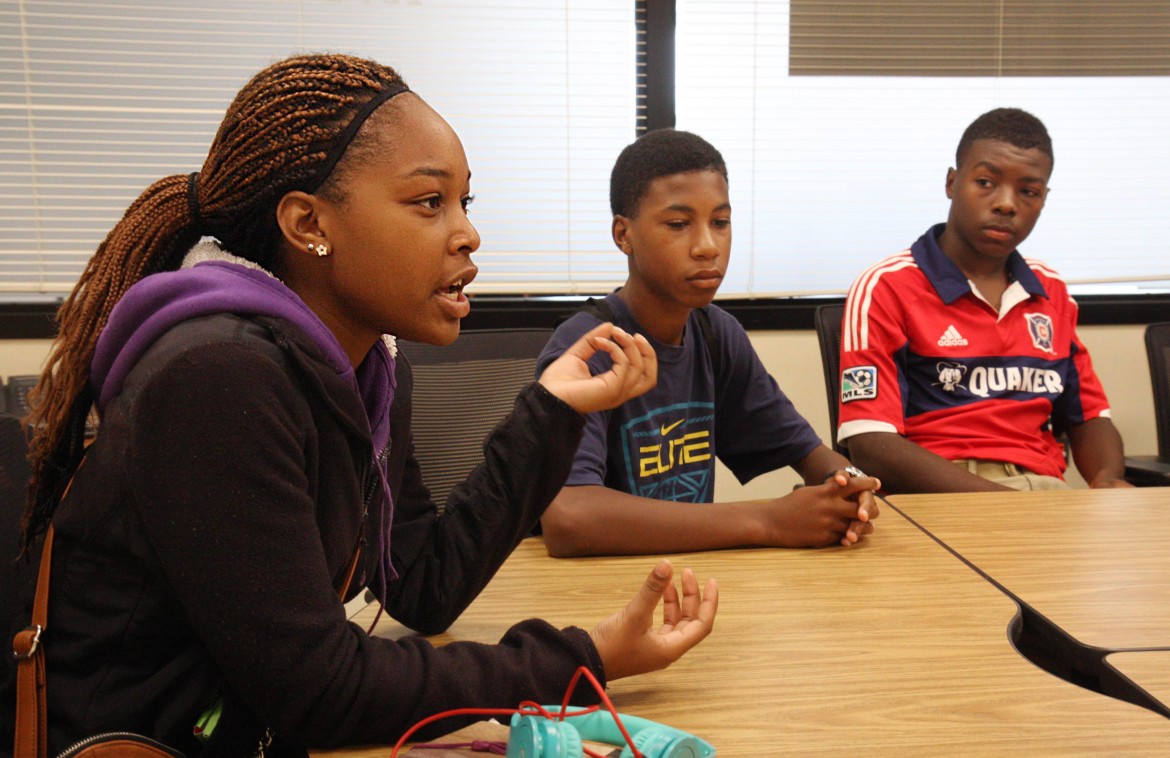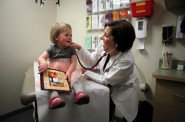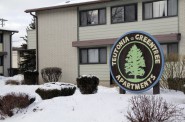State Has Worst Black-White Learning Gap
Despite decades of efforts to close gap, little improvement has occurred.
A ‘vicious cycle’
Wisconsin’s “stagnant” gaps can largely be traced to the influence of economic disparities and trends, said Carl, the UW-Madison education researcher.
Up until the 1950s and ’60s, manufacturing-based cities like Milwaukee had enough jobs to support a middle-class lifestyle for those with only a high school education, Carl said. As manufacturing jobs — the “backbone” of the city — began to disappear in about the 1970s due to factors such as increased foreign competition, outsourcing and greater automation, he said, Milwaukee and other “Rust Belt” cities saw a decline in population and a shift to an increasingly poor and non-white population.
Because of “white flight” to the suburbs, Carl said, housing values fell in the city, resulting in fewer resources for school districts, which relied largely on local property taxes.

Eric Grodsky is an associate professor of sociology at the University of Wisconsin-Madison and an expert on inequality in higher education. Grodsky is leading a $5.2 million effort to study which strategies may help close the huge gap between how well black and white students perform in Wisconsin schools. Photo by Abigail Becker of the Wisconsin Center for Investigative Journalism.
“Cumulatively, the result of job losses, falling property values and rising crime rates for inner-city school districts has been a slow and steady process of decline, which has been very difficult to reverse,” Carl said.
“This becomes this vicious cycle that, by and large, we’re fully in the throes of.”
Racial academic disparities are often also rooted in greater social inequality issues, said Eric Grodsky, a UW-Madison associate professor in sociology and educational policy studies who researches disparities in higher education.
Grodsky said Wisconsin’s black residents are, on average, worse off than in other states with a similar racial makeup, and the state lacks an “established” black middle class.
The Race to Equity report, released in 2013 by the nonprofit Wisconsin Council on Children and Families, affirms Grodsky’s analysis. Compared to non-Hispanic whites, blacks in Wisconsin were nearly four times as likely to be unemployed and four times as likely to be living in poverty, earning about half as much in median household income as whites.
Said Grodsky: “If you change the class structure of society, yes, you would make a big dent in the disparities, but that is not going to happen.”
Few proven remedies to narrow gap
Carl said there are not enough large-scale evaluations showing which programs are successful in closing the achievement gap.
He could only point to one set of programs that he said has been proven successful: the in-school Advancement Via Individual Determination (AVID) class and the related Teens of Promise (TOPS) programs that Madison East’s Ceesay credited with helping her get into UW-Madison.
TOPS is an after-school and summer program that works with AVID to prepare the “academic middle” for college through summer internships, tutoring and mentorships and college visits. The programs are an effort of the Madison School District and the Dane County Boys & Girls clubs.
Carl said the fact that there are so few programs in Wisconsin backed up by sufficient research “is pretty indicative of the problem.”
But the newly announced $5.2 million federal grant may change that. Over the next four years, education researchers from DPI and the Wisconsin Center for Education Research will analyze data from all public schools to identify practices across the state that are working to close the achievement gap.
After the research center identifies schools where racial and economic achievement gaps are narrowing, Grodsky will lead a university research team to conduct on-site interviews with school officials to identify effective practices that other districts can replicate.
Grodsky said the work will build on Evers’ Promoting Excellence for All task force by figuring out “the extent to which those ideas will have traction in the broader state.”
Langston Evans, who runs Madison TOPS, said it will take more than schools. Nonprofit organizations and local businesses also must exercise a “collective will” to help students.
“If we aren’t coordinating and collaborating the services that bridge those together, then everybody is going to feel like the other person is to blame,” Evans said.
Collaboration involves parents and families, too.

Madison Memorial High School sophomore William Lemkuil looks at a wall of family photos with his mother, Amy, in the basement of their home in Verona. Amy says she worries about the negative stereotypes that William faces as a black student in Wisconsin. Photo by Abigail Becker of the Wisconsin Center for Investigative Journalism.
Amy Lemkuil is as involved in her son William’s education as she was with her two older daughters, who are now in college. Lemkuil acknowledges that with her resources and flexible job, she can spend time at school, pay a tutor and work around William’s school and sports schedule.
“There just is socioeconomic privilege,” Lemkuil said.
Where these resources are lacking, community members such as Pat Wongkit step in. Wongkit is the program coordinator at Northport Community Learning Center, located within a low-income apartment complex on Madison’s north side.
She acknowledges some parents are working multiple jobs, caring for children at home and enduring numerous stresses. But they “can’t just hand over the kids too and have us do all the work,” Wongkit said.
She encourages parents to check students’ backpacks for homework, keep track of school events and send their children to learning center programs.
“We count on the parents to help us, making sure the kids are here,” Wongkit said. “We need parents, we need a community and we need the schools, so all of us need to be in sync.”
A reason to come to school

Sophomores William Lemkuil, center, and Demitrius Kigeya, right, listen to Danaejuh Sheppard during a roundtable discussion with other students from Madison Memorial High School’s Black Student Union in August. Sheppard, a senior, discusses a proposed mentoring program at the high school that would partner younger students with older students. Photo by Joseph W. Jackson III of the Wisconsin Center for Investigative Journalism.
Student leaders also can play a part. Some of Memorial’s Black Student Union members, including Kigeya and Lassey, said they are working to change how others perceive minority students at school and in the greater Madison community.
JoAnne Brown, Memorial’s multicultural student coordinator, said BSU members are leaders “shining lights onto other African-Americans, showing that they can do this too.”
Danaejuh Sheppard, a senior, said she and other BSU members are creating a peer-to-peer program to partner younger students with older student mentors. She plans to attend college to be a pediatrician, paramedic or a nurse practitioner.
Brown said there is a gap at Memorial between black students like Sheppard and other BSU members who are succeeding and another set of black students who are not. BSU students at a recent roundtable discussion on the achievement gap at Memorial said a variety of factors may be at play: feeling disconnected from teachers, lack of encouragement at home and different learning styles that they say teachers are not accommodating.
“Our African-American students aren’t really connecting to (teachers),” Sheppard agreed. “They just think teachers don’t understand where they’re coming from and their history.

From left to right and back to front, Robert Bennett, Demitrius Kigeya, Odoi Lassey and William Lemkuil walk down the halls of Madison Memorial High School. Even though these four students are high-achieving, participate in sports and are active members of the school’s Black Student Union, they still face negative stereotypes as black students in Madison. Photo by Abigail Becker of the Wisconsin Center for Investigative Journalism.
“Other people can help, they can tell you go to go class, they can tell you to do certain things, but it’s also up to you to think, ‘Oh maybe I do need to do this, actually go to class,’” she added. “But you can’t really have someone force you to do something you don’t want to do.”
Students also need a plan, Lassey said, whether or not that includes college. Lassey is taking a law and ethics course and says he wants to get a law degree like his father and maybe practice corporate law. Kigeya aims to play soccer in college and may pursue a career in physical therapy.
“I think the reason people succeed is because they have a goal in mind … that’s what makes people want to work hard is knowing they have a plan after high school,” Lassey said.
Robert Bennett, a junior who wants to pursue college basketball and veterinary science in college, agreed. He said racial stereotypes will never go away — a belief expressed by almost all the students at the roundtable in August. But he said self-motivation might help diminish them.
“Instead of having a reason to leave, having a reason to come here and do what they have to do, and then after awhile stereotypes will start going down,” Bennett said. “(Stereotypes will) still be there, but if the majority of people that are black start doing what the normal is — going to school, doing everything you have to do — then stereotypes will slowly start to go away.”
The nonprofit Wisconsin Center for Investigative Journalism (www.WisconsinWatch.org) collaborates with Wisconsin Public Radio, Wisconsin Public Television, other news media and the UW-Madison School of Journalism and Mass Communication. All works created, published, posted or disseminated by the Center do not necessarily reflect the views or opinions of UW-Madison or any of its affiliates.
Children Left Behind
-
Study Shows Poverty’s Impact on Kids
 Jul 9th, 2016 by Abigail Becker
Jul 9th, 2016 by Abigail Becker
-
Teaching Poor Kids Where They Live
 Feb 18th, 2016 by Abigail Becker
Feb 18th, 2016 by Abigail Becker
-
Wisconsin Going Backwards on Achievement Gap
 Dec 21st, 2015 by Abigail Becker
Dec 21st, 2015 by Abigail Becker





















The schools aren’t to blame .. Relatively speaking, Wisconsin has higher than average performing whites and lower than average performing minorities. As a whole, the white family structures are stronger and more dedicated to education — and more segregated — resulting in higher performance versus others.
No surprise there’s a big gap.